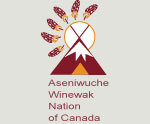Glossary
The Glossary used for this Edukit will be the same one used on the main website People of the Boreal Forest.
[ A-G ] [ H-N ] [ O-T ] [ U-Z ]
- habitat:
- Natural environment of an animal or plant.
- heel-dog
- (heeler): The dog which is hitched closest to the toboggan in a team of dogs hitched single file or in tandem. Usually the largest and strongest dog in the team.
- hew:
- The shaping of a log with an axe or draw knife for building purposes.
- hitch:
- The number of dogs hitched to a toboggan (also known as a carryall or sled) in single file, tandem, or fanned out.
- home base:
- The main residence of a trapper family.
- Indian:
- A person registered or entitled to be registered under the Indian Act of Canada.
- Indian hardwood:
- The larch (tamarack) tree, commonly used to construct snowshoe frames, and toboggan or sled runners; hard wood.
- Indigenous:
- see Native.
- jigger:
- An instrument used to feed a rope from a hole in the ice to another hole in the ice (on a river or lake). Once the rope is fed through from one hole to another, it is attached to a fish net and the net is pulled under the ice where it is set to catch fish. A jigger is two metres (six and a half feet) long and a quarter of a metre (nine inches) wide, and is affixed with a hoop and rope to propel it under the ice.
- kinnickinnick:
- A type of tobacco, given as an offering or used in spiritual rituals. Often the dried leaf of a bearberry plant or the bark of a red willow.
- lapstick:
- The bow and stern of a Chipewyan skiff that has side boards and top boards overlapping the bottom boards.
- lead-dog:
- The dog at the head of a dog-team hitch; fast, sensitive to the moves of the team; alert to the commands of the dog musher; a highly trained member of the dog team.
- lichen:
- A plant organism, many-coloured, that grows on rocks and tree trunks. It is a food supply for some mammals and is often used to decorate traditional arts and crafts.
- lick:
- ( salt lick, animal lick) A natural outcrop of minerals (salt in particular) consumed by animals as a nutritional supplement; area in which one is located.
- line cabin:
- A temporary residence used by a trapper, located on a trapline and usually within one working-day’s travel from home base or another line cabin.
- lobstick:
- A landmark used by a traveler, often consisting of a tall coniferous tree with only the topmost branches, leaves, and cones remaining; easily seen from land trails and water routes.
- log-built:
- Home or cabin built with logs.
- long-hair:
- A designation given to fur-bearing mammals with a coat of long hair.
- mainland:
- The main part of land, excluding islands.
- Métis:
- People of mixed European and Aboriginal ancestry; unique to the cultural map of Canada in that they emerged only after the arrival of the European and the subsequent intermarriage of English or French Canadian men and First Nations women. Children born of these marriages were called “Métis,” which is a French term for “mixed blood.” The Métis history and culture draws on diverse ancestral origins, including Scottish, Irish, French, Ojibway, and Cree.
- midwife:
- A person (typically a woman) who assists another woman in childbirth.
- moccasin:
- Ankle-high footwear fashioned out of tanned hide for soles and hide or other fabric for ankle support.
- moose-call:
- A cone-shaped megaphone made of birchbark, used by a hunter to imitate moose communication, usually imitating the mating messages of both male and female .
- moss:
- As in bog, swamp, peat, peat moss: a clump of plants having a small, leafy, often tufted stem.
- mukluk:
- Knee-high footwear fashioned out of tanned hide for soles, and hide, fur, or other fabric for the section covering the ankle up to the knee.
- muskeg:
- A marshy deposit of partly decayed vegetable matter, characteristic of northern regions.
- Native:
- Belonging to a particular place by birth; belonging to or associated with one by birth. A reference to persons of Canadian Aboriginal ancestry, including people who are defined as Indian, Inuit, and Métis. Synonyms: Indigenous, Aboriginal.
- Native Person:
- A member of a People who belong to or are descended from the original inhabitants of a region; in Canada, the term includes First Nations, Inuit, and Métis Persons.






